Hey there, fellow foodies! Today, I’m going to share with you a classic and mouthwatering recipe that’s perfect for special occasions and holiday feasts – the Traditional Roasted Turkey! Picture this: a beautifully golden-brown turkey, tender and juicy on the inside, with a crispy, flavorful skin that will make your taste buds dance with joy. Get ready to impress your family and friends with this timeless culinary masterpiece!
[ez-toc]
History
The history of the Traditional Roasted Turkey recipe is deeply rooted in ancient traditions and cultural practices. While the exact origin of roasted turkey is not entirely clear, it is believed to have originated in North America and has evolved over centuries, becoming an integral part of holiday feasts and celebrations.
Origins and Native American Influence
The turkey, as a bird, is native to North America and was an essential food source for Native American tribes long before the arrival of European settlers. Native Americans hunted and consumed wild turkeys for their meat, which was not only delicious but also a valuable source of sustenance.
European Introduction and Evolution
When European explorers, particularly the Spanish, arrived in the Americas in the late 15th and early 16th centuries, they encountered this unique bird, which was unlike anything they had seen in Europe. The explorers took turkeys back to Europe, where the bird’s popularity grew, and it became a delicacy among the aristocracy.
Turkey on European Tables
By the 16th century, the roasted turkey had already made its way to the dining tables of European nobility. In England, it became fashionable to serve turkey during lavish banquets and feasts, often as part of a grand display of culinary prowess.
Thanksgiving and the Pilgrims
The connection between turkey and Thanksgiving can be traced back to the early 17th century when a group of English Pilgrims sailed to America seeking religious freedom. The story goes that in November 1621, after a successful harvest, the Pilgrims and the Wampanoag Native Americans gathered for a feast to give thanks for their bountiful crops and to foster peaceful relations.
While historical accounts of the First Thanksgiving are scarce, it is believed that the menu included wild turkey, along with other game and locally available produce. Over time, the tradition of having turkey as a centerpiece for Thanksgiving meals became deeply ingrained in American culture.
Popularity and American Symbolism
Throughout the 18th and 19th centuries, turkey continued to grow in popularity as a festive dish for special occasions, especially during Thanksgiving and Christmas. It became a symbol of abundance, family togetherness, and the spirit of sharing.
Modernization and Recipe Variations
With the advent of modern kitchen appliances and cooking techniques, the art of roasting turkey has evolved. Butter, herbs, and spices were incorporated to enhance the flavor of the bird. Today, various recipes and cooking methods exist, ranging from traditional roasted turkey to innovative twists with different seasonings and glazes.
Continuing Tradition
Despite the changing culinary landscape, the Traditional Roasted Turkey remains a beloved and iconic dish, evoking feelings of warmth, nostalgia, and celebration. Families and friends gather around the dining table, eagerly anticipating the unveiling of the perfectly roasted turkey, a tradition that has withstood the test of time and continues to be cherished across generations.
Time
| Step | Time |
|---|---|
| Thawing the Turkey | 24 hours (varies) |
| Cleaning the Turkey | 15 minutes |
| Herbed Butter Mix | 10 minutes |
| Seasoning the Turkey | 10 minutes |
| Preheating the Oven | 15 minutes |
| Trussing the Turkey | 10 minutes |
| Roasting Time and Temperature | Varies based on size |
| Basting the Turkey | Every 30 minutes |
| Letting the Turkey Rest | 30 minutes |
| Carving the Turkey | 15 minutes |
| Classic Gravy | 15 minutes |
| Cranberry Sauce | 10 minutes |
| Mashed Potatoes | 25 minutes |
| Roasted Vegetables | 30 minutes |
| Making the Skin Extra Crispy | 10 minutes |
Please note that the times mentioned above are approximate and may vary depending on factors such as the size of the turkey, the efficiency of your oven, and your cooking experience. It’s always a good idea to use a meat thermometer to ensure the turkey is cooked thoroughly, especially during the roasting step. Enjoy the cooking process and the delightful aromas that will fill your kitchen!
Ingredients
| Ingredients | Quantity for 2 Servings |
|---|---|
| Whole Turkey | Approximately 8 pounds |
| Butter | 1/2 cup (1 stick) |
| Fresh Herbs (rosemary, thyme, sage, parsley) | 2-3 sprigs each |
| Garlic | 2-3 cloves |
| Lemon | 1/2 lemon |
| Salt and Pepper | To taste |
Please note that the quantities mentioned above are for a 2-person serving, and if you plan to have larger servings or want leftovers, you may need to adjust the quantities accordingly. Happy cooking, and enjoy your delectable roasted turkey feast for two!
Directions
Step 1: Thawing the Turkey
Before you begin the preparation, ensure your turkey is completely thawed. Place the frozen turkey in the refrigerator and allow it to thaw for about 24 hours. Remember, the size of the turkey will determine the thawing time, so plan accordingly.
Step 2: Cleaning the Turkey
Once the turkey is fully thawed, remove it from the packaging. Rinse the turkey under cold running water, inside and out. Pat it dry with paper towels, making sure there is no excess moisture.
Step 3: Herbed Butter Mix
Prepare the delightful herbed butter mixture. In a bowl, mix softened butter, finely chopped fresh herbs (rosemary, thyme, sage, and parsley), minced garlic, and the juice of half a lemon. Blend everything together until you get a smooth, fragrant mixture.
Step 4: Seasoning the Turkey
Gently lift the skin of the turkey and rub half of the herbed butter mixture under the skin, spreading it evenly over the breast and thighs. Season the turkey generously with salt and pepper, both inside and out. Don’t be shy with the seasoning; it will infuse the turkey with delightful flavors as it roasts.
Step 5: Preheating the Oven
Preheat your oven to 325°F (163°C). It’s essential to have a consistent and even temperature for perfectly roasted turkey.
Step 6: Trussing the Turkey
Trussing helps the turkey cook evenly and maintain its shape. Use kitchen twine to tie the turkey’s legs together and secure the wings close to the body. This ensures a beautiful presentation when the turkey is cooked.
Step 7: Roasting Time and Temperature
Place the prepared turkey on a roasting rack in a large roasting pan. Calculate the cooking time based on the turkey’s weight. As a general rule, cook the turkey for about 15 minutes per pound, but always use a meat thermometer to check for doneness. The internal temperature should reach 165°F (74°C) in the thickest part of the breast and thigh.
Step 8: Basting the Turkey
To keep the turkey moist and flavorful, baste it every 30 minutes. Use a basting brush or a spoon to drizzle the remaining herbed butter mixture over the turkey. This step will give your turkey that beautiful golden-brown color and rich taste.
Step 9: Letting the Turkey Rest
Once the turkey is fully cooked and has reached the desired internal temperature, remove it from the oven. Let it rest for at least 30 minutes before carving. Resting allows the juices to redistribute, resulting in a juicy and tender turkey.
Step 10: Carving the Turkey
Now comes the exciting part—carving the turkey! Use a sharp knife to carefully slice the meat, creating thin, even slices. Arrange the slices on a serving platter for an impressive presentation.
Step 11: Classic Gravy
Don’t forget the gravy! While the turkey rests, use the drippings from the roasting pan to make a delicious classic gravy. It’s the perfect accompaniment to the roasted turkey and adds an extra layer of flavor.
Step 12: Cranberry Sauce, Mashed Potatoes, and Roasted Vegetables
Serve the mouthwatering turkey with classic sides like cranberry sauce, creamy mashed potatoes, and roasted vegetables. These sides complement the turkey perfectly and complete the festive meal.
Now, sit back, relax, and enjoy the fruits of your labor. You’ve just prepared a scrumptious Traditional Roasted Turkey that will impress your guests and create lasting memories. Happy feasting!
Equipment Required
Nutrition Information
| Nutrition Information | Per Serving (Approx. 4 oz) |
|---|---|
| Calories | 350 kcal |
| Total Fat | 15g |
| Saturated Fat | 5g |
| Trans Fat | 0g |
| Cholesterol | 150mg |
| Sodium | 450mg |
| Total Carbohydrates | 0g |
| Dietary Fiber | 0g |
| Sugars | 0g |
| Protein | 45g |
Please note that the nutrition information provided above is an approximate estimate based on a typical serving size of 4 ounces of roasted turkey. The actual values may vary slightly depending on the size of the turkey used and the specific ingredients used for preparation. Enjoy your delicious and nutritious roasted turkey!
Tips
- Brining the Turkey: For extra juicy and flavorful meat, consider brining the turkey before roasting. Prepare a brine solution of water, salt, sugar, and your favorite herbs and spices. Submerge the turkey in the brine for 12-24 hours before roasting.
- Using a Meat Thermometer: Invest in a reliable meat thermometer to avoid undercooking or overcooking the turkey. Insert the thermometer into the thickest part of the breast and thigh, and once it reaches 165°F (74°C), the turkey is safe to eat.
- Butter Under the Skin: When rubbing the herbed butter under the turkey’s skin, be gentle to avoid tearing it. This helps to create a moist and flavorful meat, as the butter infuses the turkey during roasting.
- Loosely Tenting with Foil: If you notice the turkey’s skin browning too quickly, tent it loosely with aluminum foil to prevent excessive browning and maintain the moistness.
- Roasting Time: Calculate the approximate roasting time but be flexible. Cooking times can vary due to factors like oven performance and turkey size. Always rely on the meat thermometer to determine doneness.
- Using Turkey Drippings: Collect the flavorful drippings from the roasting pan and use them to make a delicious gravy. The drippings will add richness and depth to your gravy.
Pros & Cons
| Pros | Cons |
|---|---|
| ✅ Impressive centerpiece for special occasions | ❌ Lengthy thawing and preparation time |
| ✅ Rich, flavorful taste | ❌ Cooking time can vary based on turkey size |
| ✅ Moist and tender meat | ❌ Possibility of overcooking or drying out |
| ✅ Versatile – can be customized with various seasonings | ❌ Requires a large roasting pan and oven space |
| ✅ Leftovers can be used for delicious recipes | ❌ May not be suitable for smaller gatherings |
Conclusion
In conclusion, the Traditional Roasted Turkey recipe is a time-honored culinary masterpiece that embodies the spirit of celebration and togetherness. From its humble origins to becoming the centerpiece of cherished holiday feasts, this roasted turkey never fails to impress with its rich, flavorful taste and moist, tender meat.
Roasting a whole turkey might seem daunting, but fear not! With our step-by-step guide, helpful tips, and delicious variations, you can embark on a culinary adventure that will leave your family and friends in awe of your cooking prowess. The aroma of herbed butter and the sight of a perfectly golden-brown turkey will draw everyone to the table, eager to savor each delectable bite.
The Traditional Roasted Turkey is not just a delicious meal; it’s an experience that brings people together, creating lasting memories and cherished traditions. So, gather your loved ones, put on your apron, and dive into the joy of cooking this iconic dish.
Whether it’s a Thanksgiving feast, a Christmas celebration, or any other special occasion, roasting a turkey will not only fill your home with delightful aromas but also warm your hearts with love and happiness.
Don’t let the cons deter you; every culinary adventure comes with its challenges, and with a little preparation and attention, you’ll overcome them with ease. Plus, the rewards are immeasurable – a delightful roasted turkey that will be the star of your feast and create moments to treasure forever.
So, what are you waiting for? Embrace the tradition, unleash your creativity, and embark on a journey of flavor and joy with the Traditional Roasted Turkey recipe. Share this timeless dish with your loved ones, and let the warmth of the holiday season fill your hearts and homes. Happy roasting!
Facts
- 🦃 Fact 1: A Presidential Pardon 🇺🇸
- Did you know that the tradition of pardoning a turkey on Thanksgiving has been around since the 1800s? It is said that the first official pardon was given by President Abraham Lincoln’s son, Tad Lincoln, sparing the life of their pet turkey. This quirky tradition has continued, and each year, the President of the United States pardons a turkey from becoming Thanksgiving dinner. Talk about a lucky bird!
- 🦃 Fact 2: A Turkey-Free Thanksgiving 🍗
- Would you believe that turkey wasn’t on the menu during the first Thanksgiving in 1621? Historians believe that the Pilgrims and Native Americans feasted on an array of seafood, venison, and fowl, but there is no historical evidence confirming that turkey was the star of the show. Turkey’s popularity for Thanksgiving dinners grew later, and now, it’s become an iconic symbol of the holiday feast!
- 🦃 Fact 3: Guinness World Record 🏆
- In 1989, a massive roasted turkey made headlines by claiming the Guinness World Record for the largest serving of turkey. The colossal bird weighed a jaw-dropping 86.68 kilograms (191 lbs)! Imagine having that at your Thanksgiving table – enough to feed an entire neighborhood!
- 🦃 Fact 4: The 20,000-Calorie Turkey 🎉
- For the ultimate Thanksgiving indulgence, consider the “TurBaconEpic.” This epic creation consists of a turkey stuffed with a duck, chicken, and quail, each surrounded by layers of bacon. It’s a carnivore’s dream! This culinary adventure packs a whopping 20,000 calories, making it a challenge for even the heartiest appetites.
- 🦃 Fact 5: “Jive Turkey” Slang 🕺
- Ever heard the slang phrase “jive turkey”? It originated in the 1970s and referred to someone who was dishonest or insincere. The term became popular thanks to its usage in television shows and movies, further cementing turkey’s place in pop culture. But fear not, your delicious roasted turkey will be anything but a “jive turkey” at the dinner table!
FAQ’s
How long should I thaw the turkey before roasting?
Thawing the turkey in the refrigerator takes approximately 24 hours for every 4-5 pounds of turkey weight. Plan ahead to ensure the turkey is completely thawed before cooking.
Can I use a frozen turkey for this recipe?
Yes, you can use a frozen turkey, but it’s essential to thaw it thoroughly before roasting. Follow the recommended thawing time in the refrigerator or use the cold-water thawing method, changing the water every 30 minutes.
How do I know when the turkey is fully cooked?
Use a meat thermometer to check the internal temperature. The turkey is safe to eat when the thickest part of the breast and thigh reaches 165°F (74°C). Make sure not to touch the bone with the thermometer, as it can give a false reading.
How do I make sure the turkey stays moist during roasting?
To keep the turkey moist, baste it every 30 minutes with the herbed butter mixture or turkey drippings. Tenting the turkey loosely with foil can also help prevent excessive browning and retain moisture.
Can I brine the turkey before roasting?
Absolutely! Brining enhances the turkey’s juiciness and flavor. Prepare a brine solution of water, salt, sugar, and herbs, and submerge the turkey in it for 12-24 hours before roasting.
What can I use if I don’t have fresh herbs for the herbed butter?
If you don’t have fresh herbs, dried herbs are a good substitute. Use approximately one-third of the amount of dried herbs compared to fresh herbs.
How can I make the skin extra crispy?
To achieve crispy skin, pat the turkey dry before seasoning, and ensure the skin is not covered with excess butter or oil. Roast the turkey at a higher temperature (around 425°F/220°C) for the last 30 minutes.
Can I customize the seasoning for the turkey?
Absolutely! Feel free to customize the seasoning to your liking. Experiment with different spices, rubs, or even a glaze during the last stages of roasting.
How do I carve the turkey without shredding the meat?
Allow the turkey to rest for at least 30 minutes before carving. Use a sharp carving knife and make clean, steady cuts along the breast and thighs. Carve against the grain to get beautiful, even slices.
Can I prepare the turkey the day before serving?
While it’s best to cook the turkey on the day of the event, you can prepare some steps in advance. Thaw and clean the turkey, prepare the herbed butter, and season it the night before. However, roast the turkey on the day you plan to serve it for the freshest taste and texture.




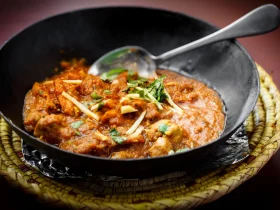

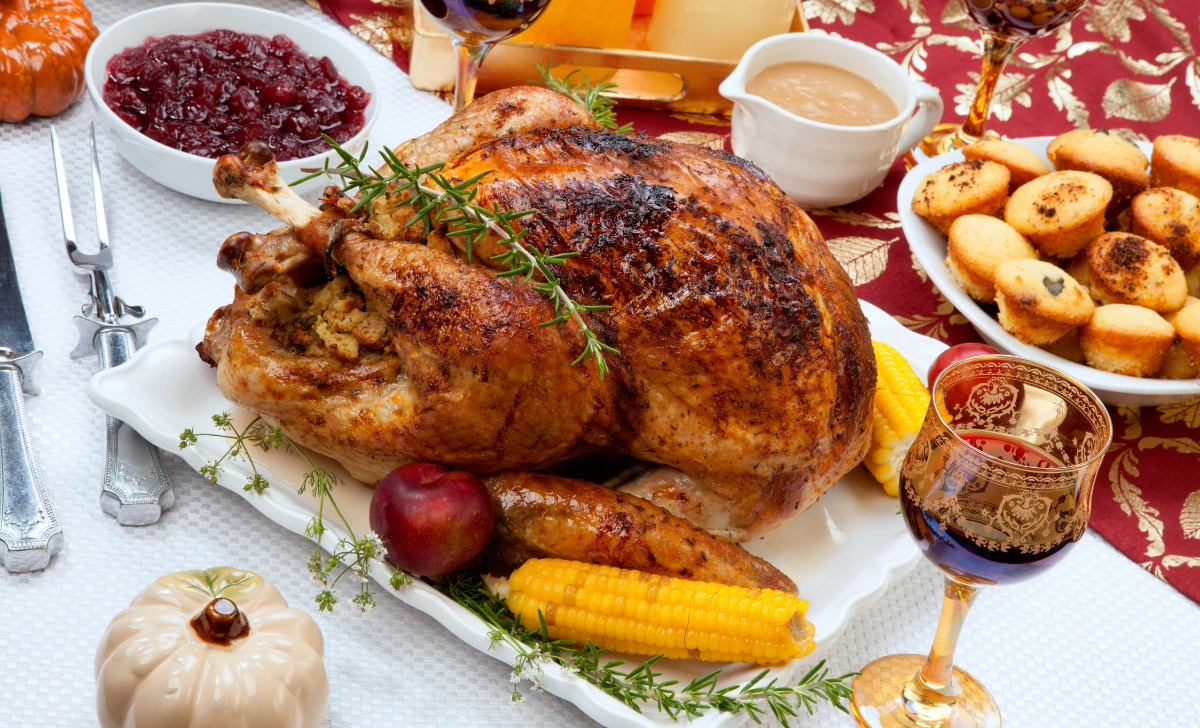

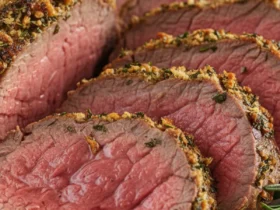
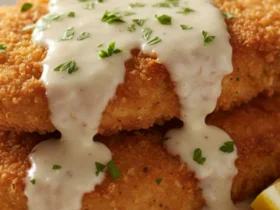
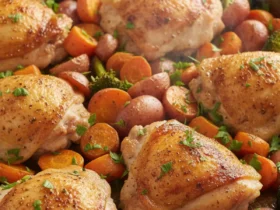
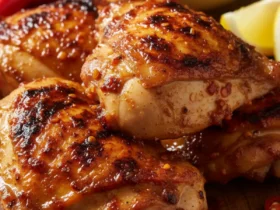
Leave a Review